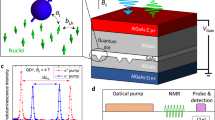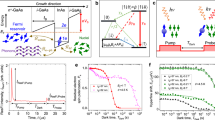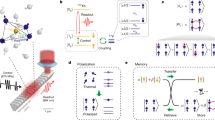Abstract
The control of solid-state qubits requires a detailed understanding of the decoherence mechanisms. Despite considerable progress in uncovering the qubit dynamics in strong magnetic fields1,2,3,4, decoherence at very low magnetic fields remains puzzling, and the role of quadrupole coupling of nuclear spins is poorly understood. For spin qubits in semiconductor quantum dots, phenomenological models of decoherence include two basic types of spin relaxation5,6,7: fast dephasing due to static but randomly distributed hyperfine fields (∼2 ns)8,9,10,11 and a much slower process (>1 μs) of irreversible monotonic relaxation due either to nuclear spin co-flips or other complex many-body interaction effects12. Here we show that this is an oversimplification; the spin qubit relaxation is determined by three rather than two distinct stages. The additional stage corresponds to the effect of coherent precession processes that occur in the nuclear spin bath itself, leading to a relatively fast but incomplete non-monotonic relaxation at intermediate timescales (∼750 ns).
This is a preview of subscription content, access via your institution
Access options
Subscribe to this journal
Receive 12 print issues and online access
$259.00 per year
only $21.58 per issue
Buy this article
- Purchase on SpringerLink
- Instant access to full article PDF
Prices may be subject to local taxes which are calculated during checkout



Similar content being viewed by others
References
Cywinski, L., Witzel, W. M. & Das Sarma, S. Electron spin dephasing due to hyperfine interactions with a nuclear spin bath. Phys. Rev. Lett. 102, 057601 (2009).
Witzel, W. M. & Das Sarma, S. Quantum theory for electron spin decoherence induced by nuclear spin dynamics in semiconductor quantum computer architectures: Spectral diffusion of localized electron spins in the nuclear solid-state environment. Phys. Rev. B 74, 035322 (2006).
Bluhm, H. et al. Dephasing time of GaAs electron-spin qubits coupled to a nuclear bath exceeding 200 μs. Nature Phys. 7, 109–113 (2010).
Zhao, N., Ho, S.-W. & Liu, R.-B. Decoherence and dynamical decoupling control of nitrogen vacancy center electron spins in nuclear spin baths. Phys. Rev. B 85, 115303 (2012).
Merkulov, I. A., Efros, A. L. & Rosen, M. Electron spin relaxation by nuclei in semiconductor quantum dots. Phys. Rev. B 65, 205309 (2002).
Khaetskii, A. V., Loss, D. & Glazman, L. Electron spin decoherence in quantum dots due to interaction with nuclei. Phys. Rev. Lett. 88, 186802 (2002).
Al-Hassanieh, K. A., Dobrovitski, V. V., Dagotto, E. & Harmon, B. N. Numerical modeling of the central spin problem using the spin-coherent-state P representation. Phys. Rev. Lett. 97, 037204 (2006).
Faribault, A. & Schuricht, D. Spin decoherence due to a randomly fluctuating spin bath. Phys. Rev. B 88, 085323 (2013).
Braun, P.-F. et al. Direct observation of the electron spin relaxation induced by nuclei in quantum dots. Phys. Rev. Lett. 94, 116601 (2005).
Dou, X. M., Sun, B. Q., Jiang, D. S., Ni, H. Q. & Niu, Z. C. Electron spin relaxation in a single InAs quantum dot measured by tunable nuclear spins. Phys. Rev. B 84, 033302 (2011).
Johnson, A. C. et al. Triplet–singlet spin relaxation via nuclei in a double quantum dot. Nature 435, 925–928 (2005).
Erlingsson, S. & Nazarov, Y. Evolution of localized electron spin in a nuclear spin environment. Phys. Rev. B 70, 205327 (2004).
Testelin, C., Bernardot, F., Eble, B. & Chamarro, M. Hole-spin dephasing time associated with hyperfine interaction in quantum dots. Phys. Rev. B 79, 195440 (2009).
Abragam, A. The Principles of Nuclear Magnetism (Clarendon, 1973).
Koppens, F. H. L., Nowack, K. C. & Vandersypen, L. M. K. Spin echo of a single electron spin in a quantum dot. Phys. Rev. Lett. 100, 236802 (2008).
Petta, J. R. et al. Coherent manipulation of coupled electron spins in semiconductor quantum dots. Science 309, 2180–2184 (2005).
Press, D. et al. Ultrafast optical spin echo in a single quantum dot. Nature Photon. 4, 367–370 (2010).
Zhang, W., Dobrovitski, V. V., Al-Hassanieh, K. A., Dagotto, E. & Harmon, B. N. Hyperfine interaction induced decoherence of electron spins in quantum dots. Phys. Rev. B 74, 205313 (2006).
Hackmann, J. & Anders, F. B. Spin noise in the anisotropic central spin model. Phys. Rev. B 89, 045317 (2014).
Chen, G., Bergman, D. L. & Balents, L. Semiclassical dynamics and long-time asymptotics of the central-spin problem in a quantum dot. Phys. Rev. B 76, 045312 (2007).
Maletinsky, P., Kroner, M. & Imamoglu, A. Breakdown of the nuclear-spin-temperature approach in quantum-dot demagnetization experiments. Nature Phys. 5, 407–411 (2009).
Kroutvar, M. et al. Optically programmable electron spin memory using semiconductor quantum dots. Nature 432, 81–84 (2004).
Müller, K. et al. All optical quantum control of a spin-quantum state and ultrafast transduction into an electric current. Sci. Rep. 3, 1906 (2013).
Heiss, D. et al. Selective optical charge generation, storage, and readout in a single self-assembled quantum dot. Appl. Phys. Lett. 94, 072108 (2009).
Bulutay, C. Quadrupolar spectra of nuclear spins in strained InxGa1−xAs quantum dots. Phys. Rev. B 85, 115313 (2012).
Chekhovich, E. A. et al. Structural analysis of strained quantum dots using nuclear magnetic resonance. Nature Nanotech. 7, 646–650 (2012).
Chekhovich, E. A., Hopkinson, M., Skolnick, M. S. & Tartakovskii, A. I. Suppression of nuclear spin bath fluctuations in self-assembled quantum dots induced by inhomogeneous strain. Nature Commun. 6, 6348 (2015).
Jovanov, V., Kapfinger, S., Bichler, M., Abstreiter, G. & Finley, J. J. Direct observation of metastable hot trions in an individual quantum dot. Phys. Rev. B 84, 235321 (2011).
Akimov, I. A., Hundt, A., Flissikowski, T. & Henneberger, F. Fine structure of the trion triplet state in a single self-assembled semiconductor quantum dot. Appl. Phys. Lett. 81, 4730–4732 (2002).
Sinitsyn, N. A., Li, Y., Crooker, S. A., Saxena, A. & Smith, D. L. Role of nuclear quadrupole coupling on decoherence and relaxation of central spins in quantum dots. Phys. Rev. Lett. 109, 166605 (2012).
Acknowledgements
We are very grateful to L. Cywinski for most useful and enlightening discussions. Furthermore, we gratefully acknowledge financial support from the Deutsche Forschungs Gemeinschaft via SFB-631, and the Nanosystems Initiative Munich, the EU via S3 Nano, and BaCaTeC. K.M. acknowledges financial support from the Alexander von Humboldt Foundation and the ARO (Grant W911NF-13-1-0309). Work at LANL was supported by the US Department of Energy, Contract No. DE-AC52-06NA25396, and the LDRD program at LANL.
Author information
Authors and Affiliations
Contributions
A.B. and D.R. performed the experiments and data analysis with T.S. and P.-L.A. providing expertise. A.R. carried out the sample processing. F.L. and N.A.S. performed the theoretical calculations. A.B., P.-L.A., K.M., F.L., N.A.S. and J.J.F. wrote the article. A.B., K.M. and J.J.F. conceived, led and managed the project.
Corresponding author
Ethics declarations
Competing interests
The authors declare no competing financial interests.
Supplementary information
Supplementary information
Supplementary information (PDF 2847 kb)
Rights and permissions
About this article
Cite this article
Bechtold, A., Rauch, D., Li, F. et al. Three-stage decoherence dynamics of an electron spin qubit in an optically active quantum dot. Nature Phys 11, 1005–1008 (2015). https://doi.org/10.1038/nphys3470
Received:
Accepted:
Published:
Issue date:
DOI: https://doi.org/10.1038/nphys3470
This article is cited by
-
Ideal refocusing of an optically active spin qubit under strong hyperfine interactions
Nature Nanotechnology (2023)
-
Deterministic generation of indistinguishable photons in a cluster state
Nature Photonics (2023)
-
Optical charge injection and coherent control of a quantum-dot spin-qubit emitting at telecom wavelengths
Nature Communications (2022)
-
Extending the time of coherent optical response in ensemble of singly-charged InGaAs quantum dots
Communications Physics (2022)
-
Quantum sensing of a coherent single spin excitation in a nuclear ensemble
Nature Physics (2021)



